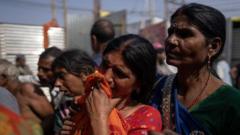As we mark forty years since the catastrophic gas leak in Bhopal, India, it serves as a somber reminder of the consequences of industrial negligence and the ongoing struggles faced by survivors.
40 Years Later: Remembering the Bhopal Gas Tragedy

40 Years Later: Remembering the Bhopal Gas Tragedy
Reflecting on an industrial disaster that scarred a nation deeply, journalists spotlight the Bhopal gas leak of 1984.
In the early hours of December 2, 1984, Bhopal became the epicenter of one of history’s most devastating industrial disasters. A catastrophic gas leak from the Union Carbide India pesticide plant unleashed a toxic cloud over the city, leading to the immediate deaths of thousands and poisoning approximately half a million residents.
Official records estimate around 3,500 casualties within the first few days. However, activists argue that the real toll has exceeded 15,000, with many survivors continuing to endure severe health impacts and ongoing suffering. The aftermath of this tragedy is felt across generations, as many children were later born with disabilities attributable to the gas exposure.
In 2010, a significant milestone was reached when an Indian court convicted seven senior managers from the plant, but they received minimal fines and short prison terms, which activists argue fall woefully short of justice for the scale of the disaster.
Union Carbide, a U.S. corporation, faced immense criticism and legal challenges, culminating in its acquisition by Dow Chemicals in 1999.
Footage from the desperate days following the leak reveals harrowing scenes: people fleeing the city in mass exodus, blinded victims receiving emergency medical care, and the haunting images littering newspapers that chronicled the unfolding tragedy.
Decades later, the derelict Union Carbide facility stands as a grim relic, painted with graffiti and memorials urging society to remember the horrors faced by the inhabitants of Bhopal. The legacy of this disaster continues to resonate, as victims and their families persistently advocate for installation of proper safety practices and adequate care, emphasizing that they will not be forgotten.
As the world reflects on this tragic anniversary, the stories of Bhopal serve to remind us of the ongoing need for accountability and justice in the aftermath of industrial negligence.
Official records estimate around 3,500 casualties within the first few days. However, activists argue that the real toll has exceeded 15,000, with many survivors continuing to endure severe health impacts and ongoing suffering. The aftermath of this tragedy is felt across generations, as many children were later born with disabilities attributable to the gas exposure.
In 2010, a significant milestone was reached when an Indian court convicted seven senior managers from the plant, but they received minimal fines and short prison terms, which activists argue fall woefully short of justice for the scale of the disaster.
Union Carbide, a U.S. corporation, faced immense criticism and legal challenges, culminating in its acquisition by Dow Chemicals in 1999.
Footage from the desperate days following the leak reveals harrowing scenes: people fleeing the city in mass exodus, blinded victims receiving emergency medical care, and the haunting images littering newspapers that chronicled the unfolding tragedy.
Decades later, the derelict Union Carbide facility stands as a grim relic, painted with graffiti and memorials urging society to remember the horrors faced by the inhabitants of Bhopal. The legacy of this disaster continues to resonate, as victims and their families persistently advocate for installation of proper safety practices and adequate care, emphasizing that they will not be forgotten.
As the world reflects on this tragic anniversary, the stories of Bhopal serve to remind us of the ongoing need for accountability and justice in the aftermath of industrial negligence.





















